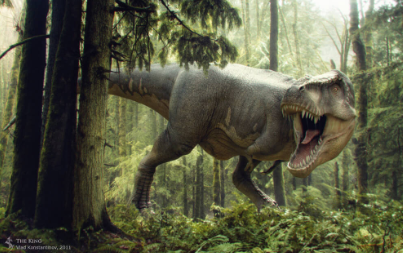万物简史(MP3+中英字幕) 第621期:冰河时代(18)
日期:2019-10-11 09:01
(单词翻译:单击)
Climate is the product of so many variables—rising and falling carbon dioxide levels, the shifts of continents, solar activity, the stately wobbles of the Milankovitch cycles—that it is as difficult to comprehend the events of the past as it is to predict those of the future. Much is simply beyond us. Take Antarctica. For at least twenty million years after it settled over the South Pole Antarctica remained covered in plants and free of ice. That simply shouldn't have been possible.
气候是多种变量的产物——二氧化硫含量的上升和下降,大陆的漂移,太阳的活动,米兰柯维契周期的变更——因此,要理解过去的事情就像预言将来的事情那样困难。许多事情我们完全无法理解。举一个例子,南极洲漂移到南极地区以后,至少有2000万年的时间,那里就一直不曾有过冰川,而是为植被所覆盖着。这一切在今天听上去简直就像天方夜谭。
No less intriguing are the known ranges of some late dinosaurs. The British geologist Stephen Drury notes that forests within 10 degrees latitude of the North Pole were home to great beasts, including Tyrannosaurus rex. "That is bizarre," he writes, "for such a high latitude is continually dark for three months of the year." Moreover, there is now evidence that these high latitudes suffered severe winters. Oxygen isotope studies suggest that the climate around Fairbanks, Alaska, was about the same in the late Cretaceous period as it is now. So what was Tyrannosaurus doing there? Either it migrated seasonally over enormous distances or it spent much of the year in snowdrifts in the dark. In Australia—which at that time was more polar in its orientation—a retreat to warmer climes wasn't possible. How dinosaurs managed to survive in such conditions can only be guessed.
有一点必须记住,要是由于无论什么原因再次开始形成冰盖,这一次有多得多的水可以利用。五大湖、哈得孙湾,以及加拿大无数的湖泊,它们那时还不存在,没有为上一个冰川期提供原料,它们是上一个冰川期的产物。
气候是多种变量的产物——二氧化硫含量的上升和下降,大陆的漂移,太阳的活动,米兰柯维契周期的变更——因此,要理解过去的事情就像预言将来的事情那样困难。许多事情我们完全无法理解。举一个例子,南极洲漂移到南极地区以后,至少有2000万年的时间,那里就一直不曾有过冰川,而是为植被所覆盖着。这一切在今天听上去简直就像天方夜谭。
No less intriguing are the known ranges of some late dinosaurs. The British geologist Stephen Drury notes that forests within 10 degrees latitude of the North Pole were home to great beasts, including Tyrannosaurus rex. "That is bizarre," he writes, "for such a high latitude is continually dark for three months of the year." Moreover, there is now evidence that these high latitudes suffered severe winters. Oxygen isotope studies suggest that the climate around Fairbanks, Alaska, was about the same in the late Cretaceous period as it is now. So what was Tyrannosaurus doing there? Either it migrated seasonally over enormous distances or it spent much of the year in snowdrifts in the dark. In Australia—which at that time was more polar in its orientation—a retreat to warmer climes wasn't possible. How dinosaurs managed to survive in such conditions can only be guessed.
更不可思议的是一些已知的晚期恐龙的栖息场所。英国地质学家斯蒂芬·特鲁里发现,北极周围10纬度范围内的森林是包括霸王龙在内的这类大动物的老家。“这简直令人费解。”他写道,“因为在这样的高纬度地区,一年中有3个月的时间处于黑暗中。”更有甚者,现在有证据显示,那些高纬度地区的冬天也十分寒冷。氧同位素研究表明,在阿拉斯加的费尔班克斯地区,白垩纪晚期的气候和现在是一样的。那么,霸王龙在那里做什么呢?它要么季节性地长距离迁徙,要么一年中有很长一段时间在冰雪交加的黑暗中度过。在澳大利亚——那时的位置比现在离南极更近——要撤到气候比较暖和的地方是不可能的。恐龙又是怎样在这样的环境中设法生存下来的呢?对此我们只能猜猜而已。

有一点必须记住,要是由于无论什么原因再次开始形成冰盖,这一次有多得多的水可以利用。五大湖、哈得孙湾,以及加拿大无数的湖泊,它们那时还不存在,没有为上一个冰川期提供原料,它们是上一个冰川期的产物。


